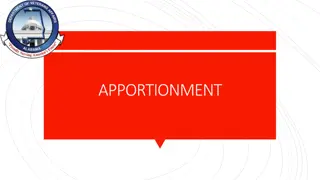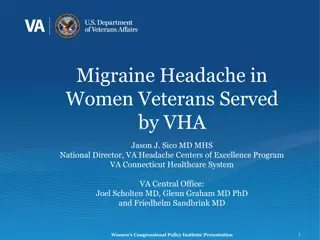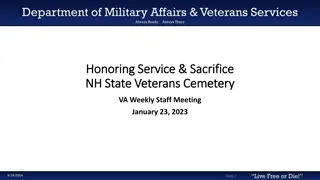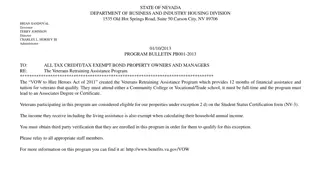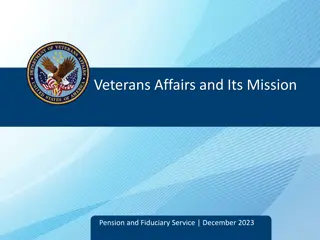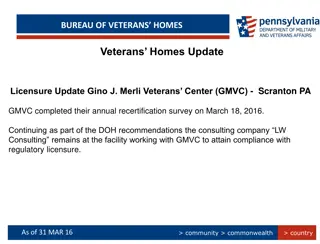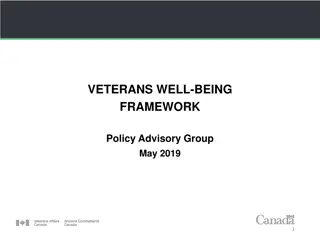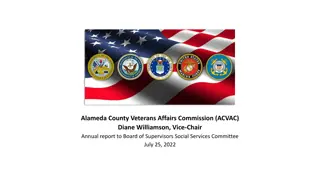Demographics and Trends in Canadian Military Veterans
The research presents data on gender-disaggregated demographics, branch distribution, military occupations, release types, disability benefits, income trends, and mental health statistics of Canadian military veterans. It highlights the growth of female representation in the military and sheds light on the differences in health outcomes between male and female veterans, emphasizing the need for better support systems.
Download Presentation

Please find below an Image/Link to download the presentation.
The content on the website is provided AS IS for your information and personal use only. It may not be sold, licensed, or shared on other websites without obtaining consent from the author. Download presentation by click this link. If you encounter any issues during the download, it is possible that the publisher has removed the file from their server.
E N D
Presentation Transcript
R e s e a r c h D i r e c t o r a t e Sex- Disaggregated Research A p r i l 2 0 1 9
2 Context: Canadian Demographics Females accounted for: 15% of the estimated Veteran population (2018) 11% of veterans in receipt of VAC benefits (2018) 16% of CAF members (2019) The Department of National Defence has declared the intention to increase the percentage of serving women to 25% by 2026.
3 Branch at Release Army Navy Air force 5 2 5 14 12 11 28 25 43 21 17 18 86 84 70 66 55 39 Male Female Male Female Male Female Regular Force Veterans Reserve Force Class C Reserve Force Class A/B
4 Military Occupation Combat Arms Administration + Engineering & Technical Medical 65 55 54 47 32 30 30 0.4 19 17 15 12 12 12 12 9 6 4 3 3 3 3 3 1 Male Female Male Female Male Female Regular Force Veterans Reserve Force Class C Reserve Force Class A/B
5 Military Release Type Voluntary Medical Involuntary 5 8 9 11 13 21 6 2 19 20 9 29 84 77 77 76 73 62 Male Female Male Female Male Female Regular Force Veterans Reserve Force Class C Reserve Force Class A/B
6 Veteran Disability Benefit Clients By Condition Hearing Loss Musculoskeletal Psychiatric Post-Traumatic Stress Disorder 90% 77% 72% 57% 53% 27% 19% 18% 15% 14% 14% 13% 5% 3% 1% 0% Male Female Male Female Canadian Armed Forces War Service
7 Average Income : 1 Year Pre -Release to 4 Years Post-Release
8 Content: Earlier Era Veterans Male and female Regular Force Veterans were more likely than Canadians to report very good or excellent mental health. No statistical difference detected between male and female Veterans. Female Reserve A/B Veterans were less likely to report very good or excellent mental health than male Veterans. Male Female * 77% * 69% 62% 61% 60% 58% Regular Force Reserve C Reserve A/B
9 Content: More Recent Veterans Regular Force female Veterans had higher rates of any mental health condition. Male Female * 31% * 23% 20% 16% Regular Force Reserve C * statistically significant difference
1 0 Forthcoming Sex-Disaggregated Research VSMS 2018 A Sex-disaggregated Comparison of Well-being Analysis of Disability Application Turnaround Times Census2021 LASS 2019
1 1 Conclusion Questions?



